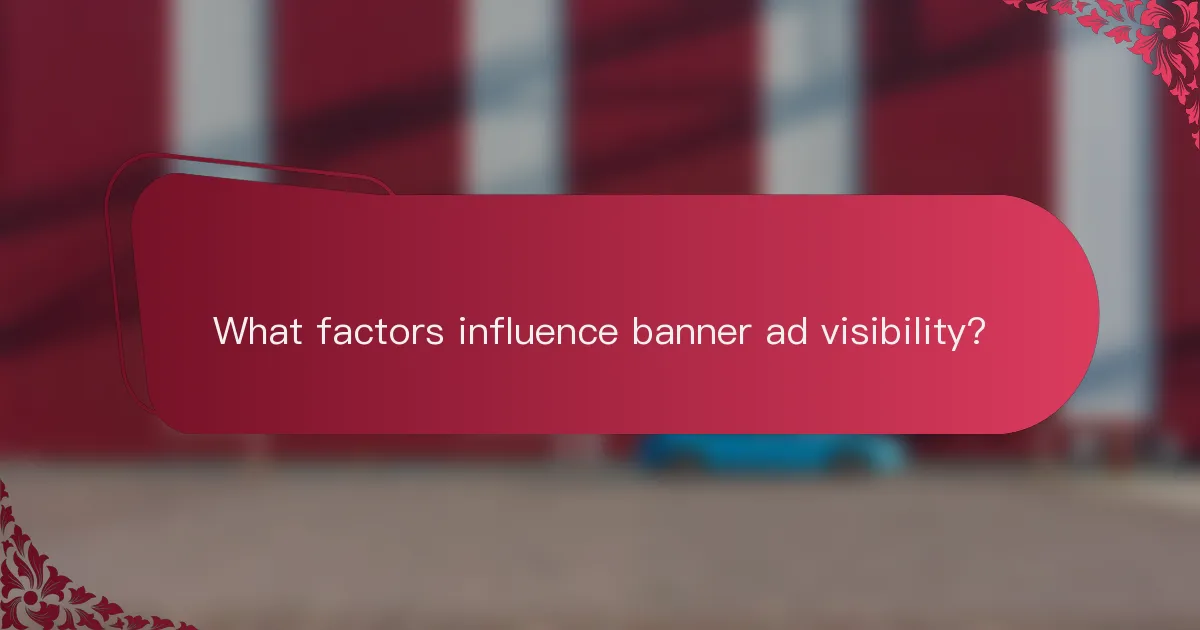Banner ads play a crucial role in digital marketing, especially in Estonia, where effective design can significantly impact user engagement. By focusing on visually appealing graphics and clear messaging, advertisers can capture attention and drive conversions. Additionally, optimizing ad visibility through strategic placement and understanding user preferences is essential for attracting and retaining audience interest.

How to design effective banner ads in Estonia?
To design effective banner ads in Estonia, focus on creating visually appealing graphics that capture attention while delivering a clear message. Incorporating local elements and understanding user behavior can significantly enhance engagement and conversion rates.
Use eye-catching visuals
Eye-catching visuals are crucial for banner ads as they draw users’ attention quickly. Use vibrant colors, high-quality images, and bold typography to create an immediate impact. Consider incorporating local cultural elements to make the ads more relatable to the Estonian audience.
Ensure that the visuals align with the brand identity and the message you want to convey. Avoid cluttered designs; simplicity often leads to better comprehension and retention.
Incorporate clear calls to action
Clear calls to action (CTAs) guide users on what to do next, such as “Shop Now” or “Learn More.” Make sure the CTA stands out visually, using contrasting colors or larger fonts to draw attention. Position the CTA prominently within the ad for maximum visibility.
Test different phrases and placements to determine which CTAs resonate best with your audience. A strong CTA can significantly increase click-through rates and conversions.
Optimize for mobile devices
With a growing number of users accessing content via mobile devices, optimizing banner ads for mobile is essential. Ensure that the ad dimensions are suitable for mobile screens and that the text is legible without zooming in.
Use responsive design techniques to adapt the layout based on the device. This approach enhances user experience and can lead to higher engagement rates.
Utilize A/B testing
A/B testing allows you to compare different versions of your banner ads to see which performs better. Test variations in visuals, CTAs, and layouts to gather data on user preferences. This iterative process helps refine your ads for better performance over time.
Track key metrics such as click-through rates and conversion rates to evaluate the effectiveness of each version. Use the insights gained to inform future ad designs.
Follow local design trends
Staying updated with local design trends can enhance the relevance of your banner ads in Estonia. Research current visual styles, color palettes, and typography that resonate with Estonian consumers.
Incorporating popular trends can make your ads feel fresh and appealing. However, ensure that these trends align with your brand’s identity and messaging for consistency.

What factors influence banner ad visibility?
Banner ad visibility is significantly influenced by several key factors, including ad placement, color usage, size, and the loading speed of the webpage. Understanding these elements can help optimize ads for better user attraction and engagement.
Ad placement on websites
The placement of banner ads on a website plays a crucial role in their visibility. Ads positioned above the fold, meaning they are visible without scrolling, tend to receive more attention compared to those placed lower on the page. Consider placing ads in high-traffic areas, such as the header or sidebar, to maximize exposure.
Additionally, context matters; ads should be relevant to the content surrounding them to enhance user engagement. For example, a travel ad on a travel blog is likely to perform better than the same ad on an unrelated site.
Use of colors and contrast
Colors and contrast are vital for making banner ads stand out. High contrast between the ad and the website background can draw the viewer’s eye, making the ad more noticeable. For instance, a bright yellow ad on a dark blue background can be very effective.
However, it’s essential to maintain brand consistency. Using brand colors can help reinforce identity while still ensuring the ad is visually appealing. Test different color combinations to find what resonates best with your target audience.
Ad size and format
The size and format of banner ads can greatly affect their visibility. Standard sizes, such as 728×90 pixels for leaderboard ads or 300×250 pixels for medium rectangles, are widely recognized and often yield better results. Using these common formats can help ensure your ads fit well within the layout of most websites.
Moreover, consider using responsive design to ensure ads look good on various devices, from desktops to smartphones. This adaptability can significantly enhance user interaction and click-through rates.
Loading speed of the webpage
The loading speed of a webpage is critical for banner ad visibility. If a page takes too long to load, users may leave before seeing the ads. Aim for a loading time of under three seconds to retain visitors and improve ad impressions.
To optimize loading speed, compress images and use efficient coding practices. Regularly test your website’s performance using tools like Google PageSpeed Insights to identify and rectify any speed issues that could hinder ad visibility.

How to attract users with banner ads?
To attract users with banner ads, focus on creating visually appealing designs that resonate with your target audience. Effective strategies include understanding your audience’s preferences, using personalized messaging, and incorporating interactive elements to enhance engagement.
Target audience segmentation
Segmenting your target audience is crucial for effective banner ads. By dividing your audience into distinct groups based on demographics, interests, or behaviors, you can tailor your ads to meet their specific needs. For instance, a travel agency might create different ads for adventure seekers versus luxury travelers.
Consider using data analytics tools to gather insights about your audience. This can help you identify which segments are most likely to engage with your ads, allowing you to allocate your budget more effectively. Aim for a mix of broad and niche segments to maximize reach and relevance.
Personalized messaging
Personalized messaging significantly increases the effectiveness of banner ads. By addressing users by their interests or previous interactions, you create a more compelling reason for them to click. For example, if a user has previously searched for hiking gear, an ad featuring hiking equipment can capture their attention.
Utilize dynamic content that changes based on user data. This approach can include location-based offers or recommendations based on past purchases. Ensure your messaging is clear and concise, highlighting the value proposition to encourage immediate action.
Incorporate interactive elements
Incorporating interactive elements into banner ads can greatly enhance user engagement. Features such as quizzes, polls, or sliders invite users to participate, making the ad experience more memorable. For example, a fashion retailer might use a style quiz to help users find outfits that match their preferences.
Keep interactive elements simple and intuitive to avoid overwhelming users. Ensure that the interaction leads to a clear call to action, guiding users toward the next step, whether it’s visiting a website or signing up for a newsletter. Test different interactive formats to see which resonates best with your audience.

What are the best practices for banner ad campaigns?
The best practices for banner ad campaigns involve setting clear objectives, monitoring performance metrics, and adjusting strategies based on analytics. Following these guidelines helps ensure that your ads are effective and reach the intended audience.
Set clear objectives
Establishing clear objectives is crucial for any banner ad campaign. Define what you want to achieve, whether it’s increasing brand awareness, generating leads, or driving sales. Specific goals, such as a target click-through rate (CTR) or a desired number of conversions, will guide your campaign’s design and execution.
Consider using the SMART criteria—Specific, Measurable, Achievable, Relevant, and Time-bound—to frame your objectives. For example, aim to increase website traffic by 20% over the next three months through targeted banner ads.
Monitor performance metrics
Regularly monitoring performance metrics is essential to understand how well your banner ads are performing. Key metrics to track include impressions, clicks, CTR, and conversion rates. These indicators provide insight into user engagement and the effectiveness of your ad placements.
Utilize analytics tools to gather data on user interactions with your ads. This information can help identify trends and areas for improvement, allowing you to make informed decisions about your campaign’s direction.
Adjust based on analytics
Adjusting your banner ad strategy based on analytics is vital for optimizing performance. Analyze the data collected to identify which ads are performing well and which are not. This may involve changing the ad design, targeting different demographics, or reallocating your budget to more successful placements.
Be prepared to iterate on your campaigns regularly. For instance, if a particular ad format or message resonates more with your audience, consider increasing its visibility while reducing investment in underperforming ads. This agile approach can significantly enhance your campaign’s overall effectiveness.

What tools can enhance banner ad effectiveness?
Several tools can significantly improve the effectiveness of banner ads by optimizing targeting, design, and performance tracking. Utilizing platforms like Google Ads, design software, and analytics tools can help in creating ads that attract users and drive conversions.
Google Ads for targeting
Google Ads is a powerful tool for enhancing banner ad targeting, allowing advertisers to reach specific audiences based on demographics, interests, and online behavior. By leveraging Google’s extensive data, businesses can create highly targeted campaigns that increase the likelihood of user engagement.
When setting up Google Ads, consider using features like remarketing to reach users who have previously interacted with your brand. This approach can yield higher conversion rates as these users are already familiar with your offerings. Additionally, utilizing A/B testing within Google Ads can help identify which ad variations resonate best with your audience.
To maximize effectiveness, ensure your banner ads are visually appealing and align with your brand message. Regularly review performance metrics such as click-through rates (CTR) and conversion rates to refine your targeting strategy and improve overall ad performance.


